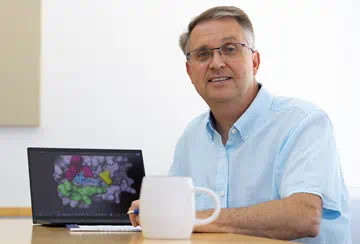For nearly half a century, KRAS has challenged cancer researchers around the world. Present in all human cells, this gene plays a critical role in pathways that regulate cell growth and survival. But when mutated, it can lock cells into a state of uncontrolled proliferation—a key driver of cancer growth. Its surface offered few places for drugs to bind, and most early inhibitors disrupted healthy KRAS as well, leading scientists to label it "undruggable."
Christopher Mohr didn't specifically set out to solve the KRAS problem. He joined Amgen in 1997 as a structural biologist, working behind the scenes to help visualize proteins at the atomic level. When a new effort began in 2013 to re-examine a common KRAS mutation, he became one of the first members of the team. His work would ultimately help reveal a hidden vulnerability in the protein, supporting the design of molecules that could bind with precision.
In 2025, that work helped Amgen and his team earn one of the highest honors in industrial chemistry: the American Chemical Society's Heroes of Chemistry award, which recognizes scientists whose work has led to successful commercialized products that benefit humankind.
The Long Arc of Patience and Precision
Mohr began his career in protein crystallography more than three decades ago, long before KRAS became the focus of his work. He had trained in the industry, developing skills in protein expression, purification, crystallization and X-ray data collection. In 1997, he joined Amgen to help grow its small molecule drug discovery program, eager to expand his expertise in macromolecular X-ray crystallography.
By 2013, Mohr was brought onto the newly formed KRAS team. His early efforts involved designing protein constructs and experimenting with crystallization conditions, which ultimately helped chemists and modelers to design small molecule inhibitors for the KRAS mutation.
"I was successful in achieving reproducible crystallization conditions that allowed me to solve co-crystal structures covalently bound with small molecules," he explains. These high-resolution X-ray structures became a visual tool for the team, revealing how their compounds interacted with the protein. "We could now observe how the small molecule compounds bind in the protein pocket and understand the key amino acid residues that were involved in binding."
What followed was a close partnership between Mohr and Amgen's medicinal chemists. Each time a compound was significantly modified—whether through different functional groups, altered cores, or new substituents—Mohr would crystallize the complex and provide an updated structure.
87 Snapshots That Changed KRAS Research
Over the course of the project, Mohr solved 130 covalent KRAS co-crystal structures. With a robust and reproducible crystallization method in place, his work informed the research of more than 25 chemists during the program's development phase.
Among those structures, one proved especially revealing, opening a new design strategy. "The discovery of the cryptic pocket was key," Mohr says. "It helped us optimize the molecule and improve both potency and stability." His 87th structure was with the molecule that would later be nominated for clinical development.
Mohr continues to contribute to Amgen's KRAS research, including a new investigational program targeting a broader range of KRAS mutations. The work builds on earlier insights but uses a different design approach aimed at addressing even more patients with KRAS-driven cancers.
The True Heroes
Scientific progress often depends on persistence through failure, and Mohr has spent years contributing to projects that never became approved medicines. Seeing this one reach patients—and earn recognition from the ACS—has been personally meaningful.
"This was the first small molecule drug I contributed to that has become a marketed product," he says. "Many other small molecule projects I worked on were not this successful. The KRAS target was thought to be undruggable, but the hard work, determination and efforts of our exceptional team proved the skeptics wrong."
Still, Mohr doesn't linger on the personal milestone. He speaks often of the patients who face limited treatment options and uncertain prognoses. For him, they are the true heroes.
"I'm humbled to be part of something that has made a difference in people's lives," he says. "This award is an honor, but the people who have to fight this disease every day—those are the people we're working for."





